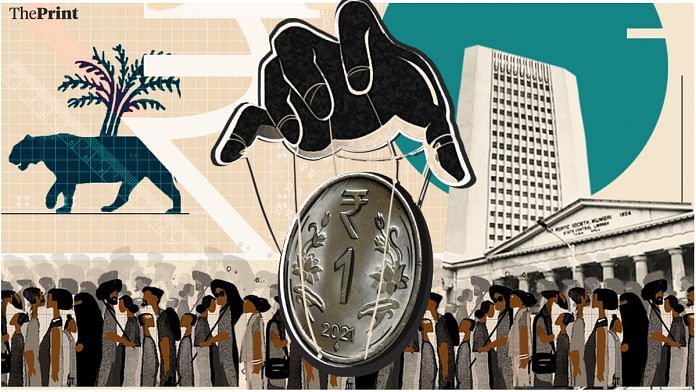The Reserve Bank of India has maintained status quo on policy rate and kept its accommodative stance unchanged. This was expected. While headline GDP has reached its pre-pandemic levels, some sectors are still below pre-pandemic levels.
The emergence of the Omicron variant could pose a downside risk to growth. At the same time, inflation is also edging up. Cost-push pressures from high raw material prices, transportation costs, and supply chain bottlenecks could impact core inflation, going forward.
While the strategy of tolerating high inflation to support growth was the right one over the last two years, going forward, the RBI needs to start normalising rates to ensure a positive real rate of interest for savers.
In response to the pandemic, monetary policy in India reduced interest rates and infused liquidity. Unlike other economies, India’s policy response to the pandemic did not involve a very large fiscal expansion. Large-scale fiscal spending by the government could have triggered inflationary concerns. This would have complicated the conduct of monetary policy.
In recent months, inflation has soared in a number of countries amid elevated commodity prices and input prices, prompting their central banks to start raising rates or accelerate the pace of monetary policy normalisation. In August, South Korea became the first major Asian economy to raise interest rates since the pandemic began. The rate hike by 25 basis points was prompted by a rise in real estate prices. Among advanced economies, the Reserve Bank of New Zealand increased interest rate by 25 basis points.
The US Federal Reserve has indicated that it is becoming more concerned about high inflation and could quicken the pace of its asset tapering schedule. In November, the Fed had announced plans to slow bond purchases by US$ 15 billion a month. Given that inflation has become more broad-based and sustained, the Fed has indicated that it could accelerate the withdrawal of support in the form of bond-buying.
Also read: Modi govt’s pandemic strategy focused on revival has worked. Economic indicators prove it
Decline in savings
Across the world, central banks responded to the Covid-19 pandemic through the provision of abundant liquidity via bond purchases. As a result, bond yields eased to all-time lows in 2020.
The RBI also responded through a series of conventional and unconventional measures to boost liquidity and lower rates.
As a result, borrowing costs in financial markets in India dropped. Yields on government bonds dropped and consequently, the yields on corporate bonds also dropped. While low interest rates helped in mitigating the impact of the pandemic on businesses and borrowers, it was a drag on savers as they earned negative returns on their savings. As growth picks up further in the next few months, interest rates need to be normalised for those who save especially in bank deposits.
In the recent period, the decline in borrowing costs has resulted in decline in returns for depositors. This has resulted in a decline in household deposits. The estimates of household financial savings by RBI shows a decline in bank deposits in the October-December quarter of 2020. In absolute numbers, household deposits fell from Rs 3.6 lakh crore in September to Rs 1.7 lakh crore in December. The ratio of household bank deposits to GDP declined to 3 per cent in the December quarter of 2020-21 from 7.7 per cent in the previous quarter.
The slide in bank deposit rates prompted greater participation by households in stock markets. Other factors like technological advancements and lockdowns have also led to a rise in retail investments. Around 10.7 million new demat accounts (for trading) were opened in 2020-21 Covid-marred year — nearly double the average trend in the preceding three years. While retail investors have been investing in IPOs, a deep correction in stock markets could impact the earnings of small investors. Given the changing valuation, strong retail investor participation may not sustain in the long run.
The recent GDP numbers show a massive jump in valuables such as gold purchased by households. Purchase of valuables surged from Rs 17,012 crore during the April-June quarter of FY22 to more than Rs 1.19 lakh crore in the July-September quarter. The jump in valuables shows that some part of household savings has moved into precious metals.
Also read: Don’t fear crypto or digital currencies, let India’s young ride the online services boom
The issue of inflation
Inflation during the pandemic was largely an outcome of supply constraints. In recent months inflation has picked up due to global headwinds such as rising crude oil prices, energy prices, and elevated commodity prices. Firms, particularly the Fast Moving Consumer Goods firms, have raised the prices of their products due to rise in input costs. Telecom charges have also been hiked.
As core inflation rises, RBI would have to raise nominal rates to ensure a positive real rate of interest for savers.
Reducing rates to benefit borrowers could be a short-term strategy, but in the long run, the financial system needs a steady flow of household financial savings to provide credit to businesses. This would require a timeline towards normalising interest rates.
Ila Patnaik is an economist and a professor at National Institute of Public Finance and Policy.
Radhika Pandey is a consultant at NIPFP.
Views are personal.
Also read: Protecting livelihoods is the next frontier for India in the fight against climate change



